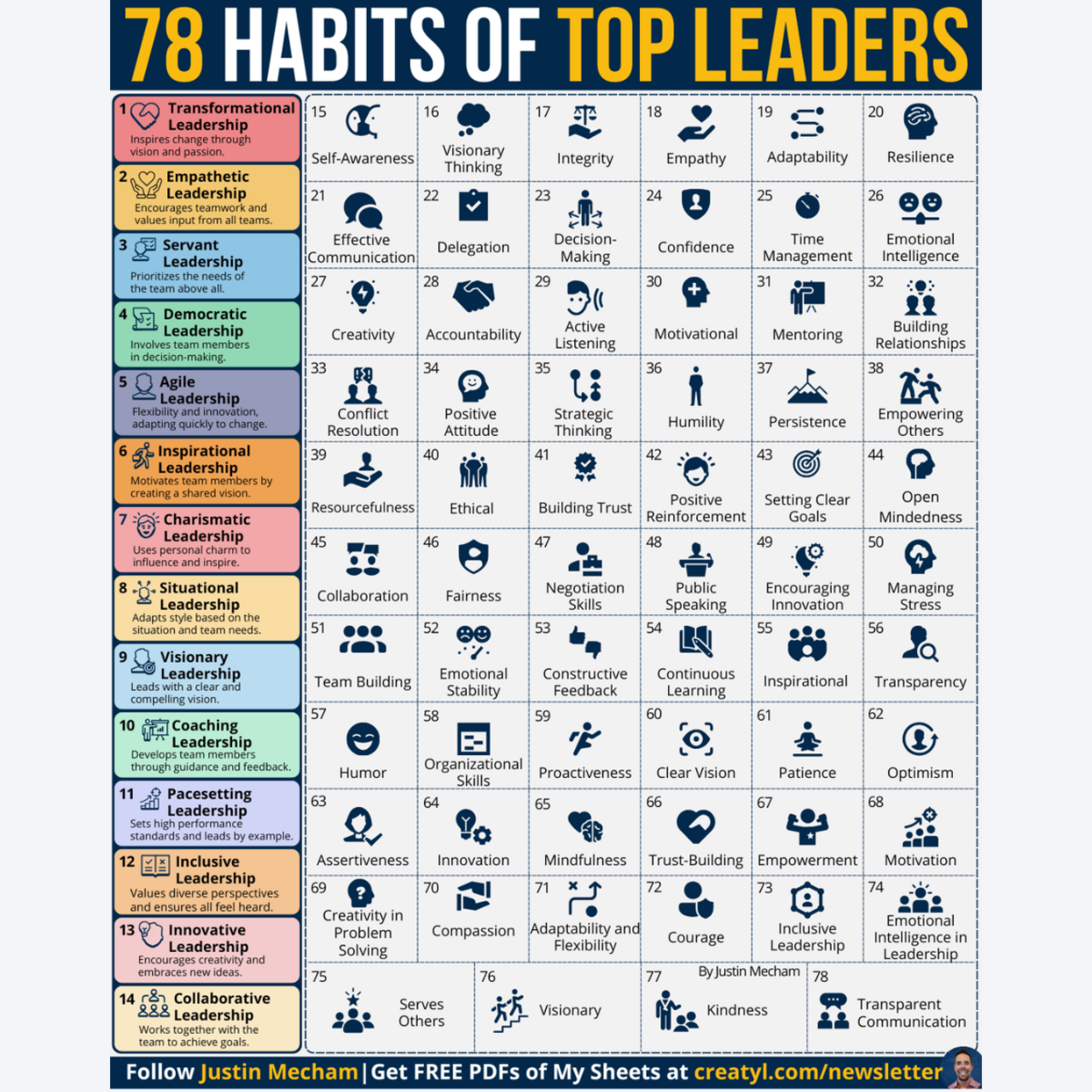If You Want Today's Infographic as PDF, Click Here.
We talk about leadership like it’s a badge you earn or a role you grow into.
But real leadership doesn’t show up on your LinkedIn profile.
It shows up in the habits people see you repeat—especially when things get hard.
It’s not about how well you speak when things are going smoothly.
It’s about what you do when everything starts to slide off the rails.
Because let’s be honest:
- People rarely remember your best day.
- They remember how you responded on your worst.
- They remember how you handled pressure, not how you performed when it was easy.
That’s the part that sticks.
Not what you meant to say. Not the intention behind your words.
But what you consistently did, over and over again—especially when you didn’t have time to plan it.
Leadership is built in the cracks—between meetings, in the moments when everything feels too tight, too loud, too much.
When the pressure’s on and eyes are watching, most people default to old patterns.
But great leaders default to something else: steady habits.
The ones they chose before it got hard. The ones that didn’t just sound good in theory, but actually worked in real life.
The Habits That Actually Make a Difference
We all want to be better leaders. But leadership advice today often gives you more than you need.
You’re handed huge lists—78 traits, 12 rules, 9 must-do actions.
It becomes easy to get stuck trying to perfect every angle and never really move forward.
Here’s what most people won’t tell you: You don’t need a dozen new habits. You need one. Just one.
Chosen intentionally, done consistently.
Not all habits are equal.
Some habits change how people experience you. Others just make you look productive.
Start by asking yourself this: What habit do I repeat when things go sideways? Do I shut down? Do I rush people? Do I disappear from view?
Now flip that. What’s one better habit I could lean into instead—one that people would feel, rely on, and remember?
Here are a few habits worth your attention:
- Build trust with consistent actions
- Listen actively so others feel heard
- Keep learning, even when you lead
- Stay resilient when things get tough
- Give feedback that helps people grow
- Set clear goals to give people direction
These aren’t just “nice to have” habits.
They’re the habits that rebuild momentum, even when your team is drained.
They bring clarity when things feel foggy. They create safety, structure, and movement.
And they require no title—just intention.
Pick one. One that fits where you are right now.
Repeat it so many times people know what to expect from you, even when you're stressed, tired, or under fire.
That’s when leadership becomes something people trust.
What It Looks Like at Work
A while back, I worked with a product team that had been strong for years but was suddenly unraveling. And not in dramatic ways.
There was no big conflict. No huge failure.
Just slow, steady disconnection.
Energy was low. People were playing it safe. Updates felt mechanical. Progress stalled.
And the manager—someone incredibly smart and well-liked—had gone quiet.
They weren’t out of touch. They were overloaded.
Their inbox was full, their calendar was packed, and their confidence had started to slip.
They weren’t making decisions as quickly. Feedback became rare.
Their presence disappeared from the day-to-day. And even though the team didn’t complain, they felt it.
And they stopped reaching out.
Instead of introducing a full new system or a team restructure, I asked the manager one thing:
“When your team looks at you during a tough week, what habit do they see? And is it helping them feel safe, clear, and supported?”
The manager paused. Then they admitted something powerful: “Right now, I don’t think they see anything at all.”
That honesty became our starting point. We picked one habit together: daily visible consistency.
We didn’t start with perfection. We started with presence.
We implemented three simple changes:
- A short daily wrap-up ritual where every team member shared what was stuck, what they were moving forward, and one thing they felt good about. It wasn’t performative. It was honest.
- On Mondays, the manager committed to sending one clear message: “Here’s what matters this week.” No slides, no fluff—just real focus.
- I met privately with each team member and asked, “What’s making your work harder than it needs to be?” We fixed the things we could immediately. We acknowledged the things we couldn’t. That alone changed everything.
The manager also made one deep shift.
They stopped trying to be perfect, and instead became dependable.
They showed up consistently. Asked better questions. And when things broke, they didn’t blame—they helped solve.
Within three weeks, the team felt completely different.
People started speaking up more.
There was laughter again. Energy felt real. Momentum picked up.
The team stopped waiting to be led—and started moving together again.
They didn’t need a whole new playbook. They just needed to see their leader leading, consistently and clearly, through action.
One small shift. One habit. Repeated.
That’s what rebuilt trust—and with it, performance.
Want to Go Deeper? Start Here.
If you're serious about becoming the kind of leader people remember long after they leave your team, start with the resources that give you real, tested insight:
Podcast: The Tim Ferriss Show – Episode with James Clear
This in-depth conversation dives into the psychology behind lasting change, the mechanics of habit-building, and why identity—not motivation—is the true driver of behavior. You’ll hear real stories, research-backed strategies, and practical takeaways you can apply immediately—especially when life gets messy.
Book: The 7 Habits of Highly Effective People by Stephen R. Covey
This isn’t just a classic—it’s a roadmap for leadership built on principle. If you want to lead with clarity, integrity, and deep personal alignment, this book is your foundation.
TED Talk: How Great Leaders Inspire Action by Simon Sinek
This talk doesn’t just explain leadership—it reveals what makes people want to follow. It’s about the emotional and psychological patterns behind great leadership, starting with why people believe in you.
These three resources cover what to do, how to build it, and why it works. Together, they’ll change not just how you lead—but how people experience you.
How People Will Tell Your Story Later
The habits you build under pressure are the legacy you leave behind.
When people describe you later, they won’t remember the one amazing meeting you ran or the perfect email you sent.
They’ll talk about what it felt like to be on your team.
They’ll describe how you made decisions when things felt uncertain.
How you handled hard conversations. How you showed up—not when it was easy, but when it was hard.
They’ll remember the habit you repeated when everything else was chaotic.
The way you responded when no one was watching. The tone you set when no one had the words.
Leadership isn’t about charisma. It’s about consistency.
It’s not about big gestures. It’s about what you do over and over again when you’re tired, uncertain, or under fire.
That’s what people remember.
That’s what builds culture. That’s what leaves a mark.
Your habit doesn’t have to be perfect. It just has to be honest, repeatable, and real.
So when people tell the story of what it was like to work with you, they’ll say: "They were steady. They were clear. And when things got hard, they didn’t disappear—they led."
And that, more than any title, will define how you’re remembered.
Download the Full Habit Infographic
Want the full list of 78 leadership habits in one place?
Download the infographic as a ready-to-print PDF. Keep it on your desk, share it with your team, or use it to pick your next leadership habit.




